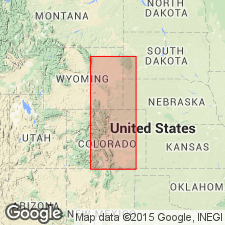
- Usage in publication:
-
- Little Horn limestone*
- Modifications:
-
- Original reference
- Dominant lithology:
-
- Limestone
- AAPG geologic province:
-
- Powder River basin
Summary:
Pg. 394-401. Little Horn limestone. Light-gray massively bedded limestone, many of lower beds of darker color and containing some sand admixture; uppermost 100 feet of formation is pure limestone. Total thickness 1,100 feet. Typical Mississippian fossils at several horizons. No fossils from basal 25 to 80 feet, and Devonian and Silurian may possibly be represented. Is in main = Madison limestone of Montana and Pahasapa limestone of Black Hills. Overlies Bighorn limestone and underlies Amsden formation without apparent unconformity. Age is Early Mississippian.
Named from fine exposures in Little Horn Canyon, on east side of Bighorn Mountains, [Sheridan Co.], northern WY.
[GNC remark (ca. 1936, US geologic names lexicon, USGS Bull. 896, p. 1197): †Littlehorn limestone abandoned. Same as Madison limestone.]
Source: US geologic names lexicon (USGS Bull. 896, p. 1197).
For more information, please contact Nancy Stamm, Geologic Names Committee Secretary.
Asterisk (*) indicates published by U.S. Geological Survey authors.
"No current usage" (†) implies that a name has been abandoned or has fallen into disuse. Former usage and, if known, replacement name given in parentheses ( ).
Slash (/) indicates name conflicts with nomenclatural guidelines (CSN, 1933; ACSN, 1961, 1970; NACSN, 1983, 2005, 2021). May be explained within brackets ([ ]).

